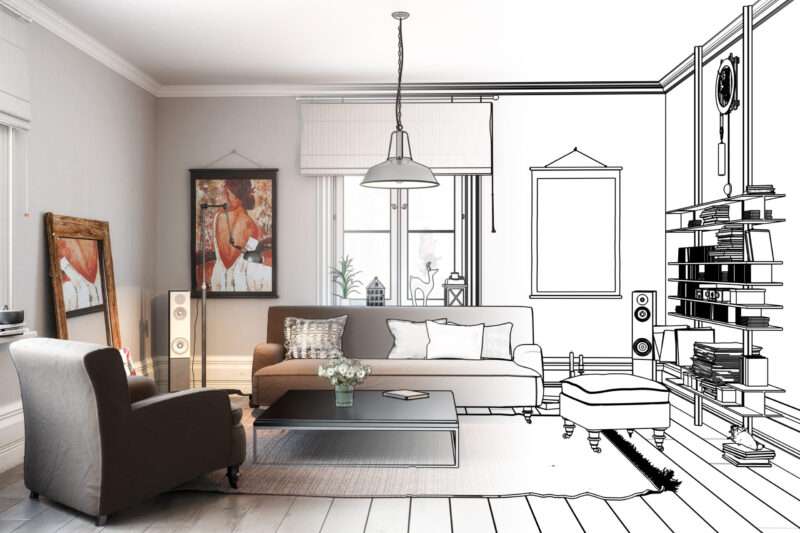The living room is known as one of the central communal zones for many households, so knowing how to plan your living room lighting can help you create the ideal illumination levels to create an inviting, yet functional room.
By combining a range of living room lighting ideas, you can create a space that is warm and relaxing for evenings, bright enough for concentrated tasks like reading, and create the perfect ambient lighting for entertaining.
As well as thinking about the different types of lighting that you might use in your living room, it’s also important to consider colour temperature, the type of light bulbs you can use, as well as innovative ways you can incorporate lighting into your living room.
Although this might sound daunting, our guide to planning living room lighting will give you all the details you need to create a perfect lighting plan.
What is the best lighting for a living room?
When it comes to your lounge lighting, there are three types of lighting you can choose from. Though every room in your house should factor in these lighting types, they become particularly important in the living room due to its multi-functionality. The three main lighting types are:
Ambient lighting
Ambient lighting, or more commonly known as general or background lighting, provides overall lighting to your room. In most cases, and particularly in living rooms, the source of ambient lighting comes from your ceiling lights, wall lights, as well as natural light.
Task lighting
As its name suggests, task lighting illuminates areas of a room where tasks need to be carried out. For a living room, task lighting is commonly used for reading purposes and can include table lamps, floor lamps and wall lights.
Accent lighting
Accent lighting is all about highlighting features in your living room, as well as providing atmosphere and mood lighting. Accent lighting should be used to highlight important artwork, objects and interesting design features in your living room. In terms of creating accent lighting in your living room, it would include using picture lights and cabinet lighting.
What are the best light bulbs to use in a living room?
The type of light bulb will also be something you need to consider when designing your living room’s lighting plan. Generally, there are two main types of light bulb homeowners use today.
LED light bulbs
LED lights for living rooms produce a bright light, and don’t give off any heat. Nowadays, this makes LED light bulbs particularly desirable as they are both energy efficient and long lasting. Though LED light bulbs come in generic white and yellow colour temperatures, RGB LED light bulbs create an array of different colours making them perfect for creating mood lighting when entertaining guests.
The brightness of these bulbs can also often be controlled remotely via a mobile device allowing you to create brighter and dimmer lighting whenever you need to.
Halogen light bulbs
Halogen light bulbs are also a bright, energy efficient option used for living room lighting. However, they do have a much shorter lifespan and can get very hot, so it is essential that they are not placed next to anything potentially flammable.
Halogen light bulbs are best used for pendant lighting and under cabinets, as the way the light reflects in these bulbs creates a warm, rich atmosphere in your living room.
Other types of light bulbs that can also be used include incandescent and fluorescent light bulbs. Though incandescent bulbs are much cheaper than LED light bulbs, they typically only last around a year and aren’t very energy efficient. Similarly, fluorescent light bulbs take time to reach their maximum brightness, meaning they aren’t great for use in heavily used rooms.
What colour lighting should you use in a living room?
As the living room is mainly used to relax, lounge lighting should not be too bright. As a result, warm lighting between 2700 and 3,300 Kelvins is considered to be a good level of brightness for a living room.
Anything brighter and you may find yourself becoming more energised, meaning you may find it more difficult to wind down at the end of the day.
How to design your living room lighting layout
Lighting is an essential aspect of any home décor, and a well-planned lighting layout can make your living room look warm, inviting, and comfortable. Whether you are renovating your living room or starting from scratch, it is crucial to plan a lighting layout that meets your specific needs. In this section, we will discuss the steps you can take to plan the lighting layout in your living room.
1. Consider Your Living Room’s Layout
Consider your living room’s layout and furniture placement. This will help you determine where you need to place lighting fixtures and how much light each area requires. For instance, if you have a seating area, you may need a floor lamp or table lamps to provide task lighting.
2. Choose the Right Type of Lighting Fixtures
There are several types of lighting fixtures you can choose from, including ceiling fixtures, floor lamps, table lamps, and wall sconces. Each type of fixture has its benefits and can add a unique touch to your living room lighting. For example, a chandelier or a gold ceiling light can add elegance to your living room, while a plug in floor lamp can provide adjustable task lighting wherever you may need it.
3. Use Layered Lighting
Layered lighting involves using multiple light sources to create a well-lit and balanced living room. You can use a combination of ambient, task, and accent lighting to achieve a layered lighting effect. For example, you can use a ceiling fixture for ambient lighting, table lamps for task lighting, and wall sconces for accent lighting.
Buy lighting for your living room with Lightbulbs Direct
Planning a lighting layout for your living room can enhance the ambiance and functionality of your space. By first determining your lighting needs, and then considering your living room’s layout, you can create a well-lit and inviting living room.
To start, why not take a look at our range of lounge lighting, here?




